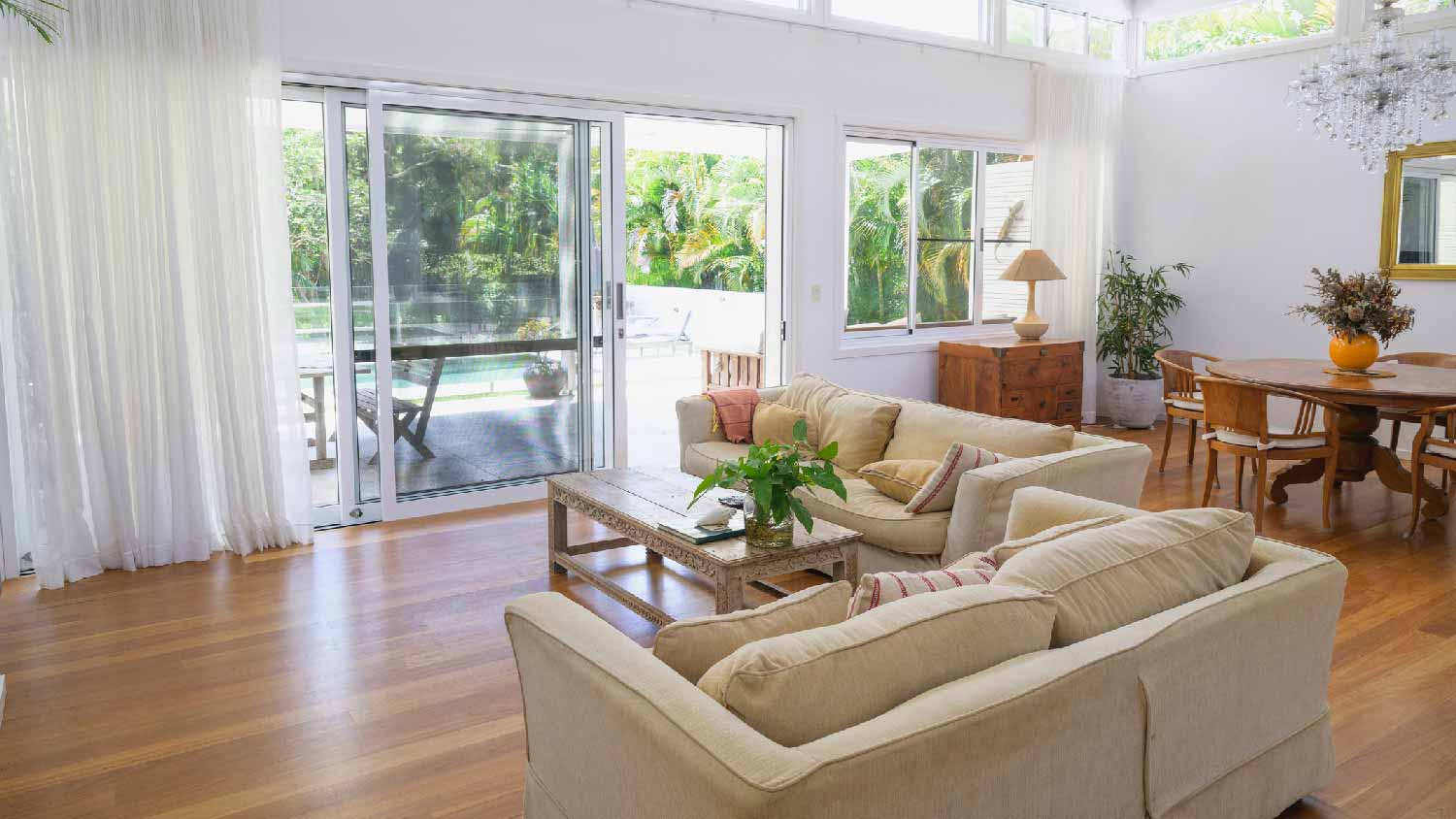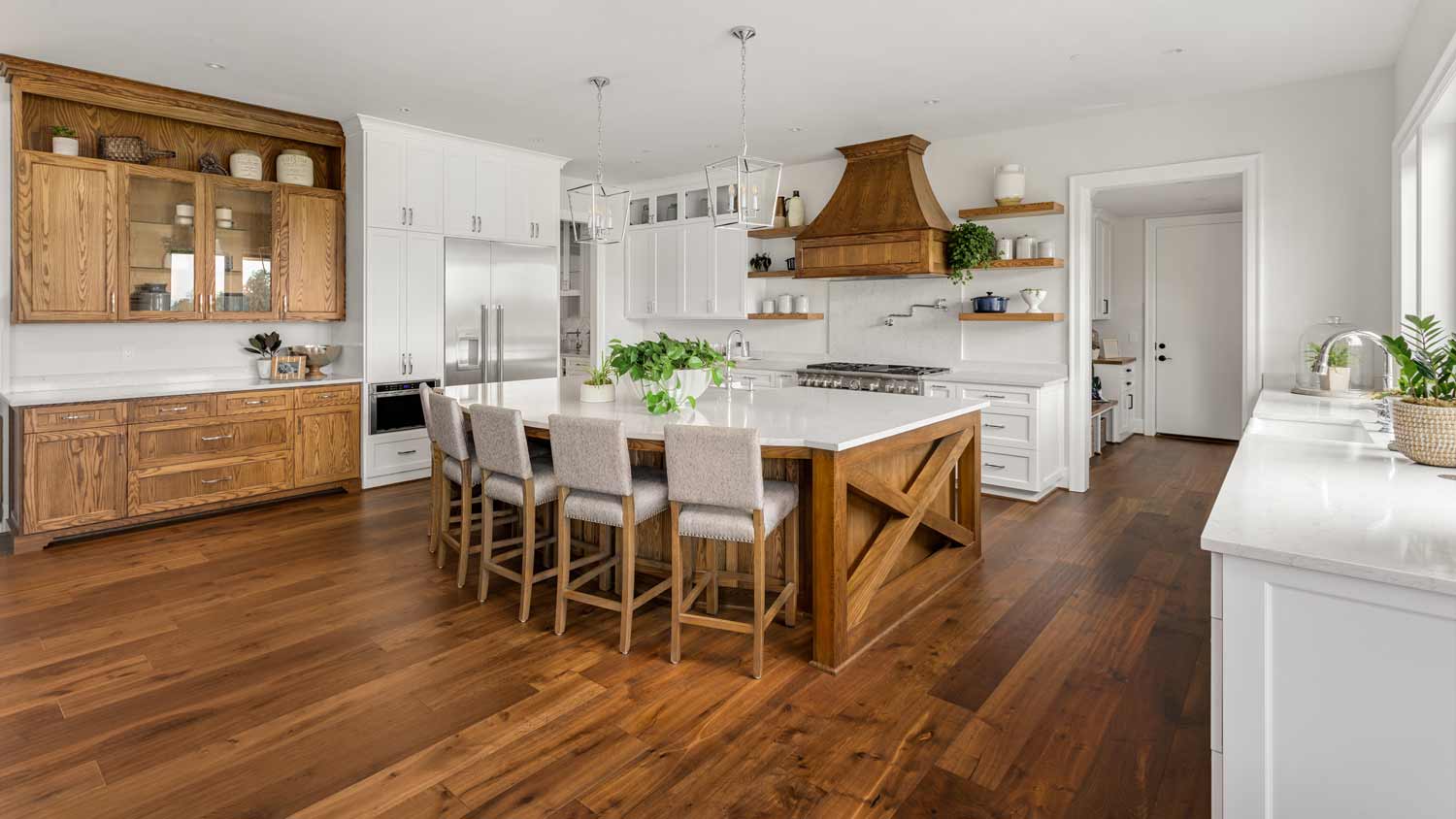
Hardwood floor repair costs depend on the problem. This guide breaks down common costs based on factors like the type of problem, repair method, and whether you hire a pro or DIY.
Create a completely custom look starting with unfinished wood floors


When you install an unfinished hardwood floor, you have a completely raw surface with no protection from daily wear and tear. The beauty of this unfinished state is that you can customize the look to whatever you want, but the finishing process can also require a lot of time and elbow grease. Use this guide to learn how to finish unfinished hardwood floors and complete your home renovation project.
The very first step is gathering all the tools you need for finishing unfinished hardwood floors. If the area you are working on is large, then you should buy or rent a drum sander and edge sander from your local flooring or hardware store. You should also decide on the shade of stain you want to use, if you decide to stain the floor. Finally, you should choose between a lacquer, varnish, or oil sealant.
One of the most important decisions you will make during this process is whether to stain the floor or not. There are some pros to doing so—for one, this is an opportunity to get the exact shade of coloring you want for your flooring. You may even try to emulate a different wood type than what you were able to budget for. Stains also bring out the beauty of the wood. You can opt, too, to leave the flooring unfinished. Some people prefer the rustic look, although you will have to take extra care to prevent damage from moisture.
Follow these steps to sand and finish an unfinished floor. You should only follow this process after your floors are fully installed. If your flooring is not installed yet, read our guide to install hardwood floors or hire a local wood floor installer nearby to lay them for you.

Before you start work, you will need to make some decisions. First, figure out if you are going to stain the floor. If you do, choose a stain that works well with your wood type. You can choose from light, medium, or dark stains, depending on the look you want. This is an opportunity to mimic the look of a specific wood type, brighten up a room with a light stain, or add elegance with a darker stain. Before you stain an entire room, consider doing a test patch so you can see how the stain will look.
Second, choose between different sealant types. Some common options are:
Water-based polyurethane
Oil-based polyurethane
Penetrating oil
Moisture-cure urethane
Wax
Shellac
Each sealant type has its own pros and cons. If you are looking for something with low levels of volatile organic compounds (VOCs), you should consider water-based polyurethane or shellac. For something durable, use oil-based polyurethane or moisture-cure urethane. If you prefer an easy-to-apply finish for a DIY job, opt for wax or penetrating oil sealer.

Before you begin the finishing process, you will need to do some basic prep work to protect yourself and your home. Take the following steps:
Seal openings: To prevent flammable dust from leaving the room, completely seal it off using plastic sheets—including doorways, electrical outlets, and air ducts with floor registers removed.
Establish ventilation: Do not seal windows, which you will want to keep accessible for ventilation. You can also use fans to help circulate air. Fans and other electrically powered equipment should be plugged into outlets in other rooms and run under your plastic sheets using extension cords.
Turn off appliances and pilot lights: Any appliance with a pilot light should be switched off as a safety precaution in case any dust does manage to escape.
Clear the room: Remove all furniture, decor, and window coverings. If you have baseboards installed, carefully remove them with a wedge and pry bar. Next, number them with a pencil so you can put them back after your project is complete.
Protect curtains: Remove or seal curtains with plastic and fold them over your curtain rods to protect them from dust and finishing products.

Cleaning your unfinished floors thoroughly will help the rest of the process go smoothly. To begin, use a vacuum cleaner to get all of the debris off the floor.
If your floor is dirty or old, you should mop it. Use a mixture of water and white vinegar to clean the floor. Mix 1/2 cup to one cup of vinegar with one gallon of warm water to make the mixture and use a damp mop (not wet). Push the broom in the direction of the wood grain. Allow your floor to dry thoroughly before moving on to the next step.

Sanding is the most challenging part of the finishing process, but you will get it out of the way first. Before sanding, don protective eyewear, earplugs, and face mask to keep yourself safe from dust and debris. Practice using the sander on a couple pieces of scrap wood to get a feel for your machine, especially if it is a rental that you have not used before.
You will need to sand the floor lightly in the direction of the wood grain using a drum sander. Your goal is to create an incredibly smooth surface before applying any stain or finish.
Accidentally gouging the floor or sanding too deeply can damage the wood.
You will need two different types of sandpaper: medium and fine grit. With the sander unplugged, insert the medium grit sandpaper first. Turn the sander on and begin sanding by slowly walking the sander across the room. Tilt the machine backward, rotate it, and go back in the other direction. Make passes back and forth across the entire room to keep the sanding even.
Use the edge sander with medium grit paper along the bases of walls and any areas your drum sander could not reach. Check your floor for cracks or gouges, and fill these in with wood putty. Once your putty is dry, repeat the process with both sanders, this time using your fine grit paper.

With the hard part out of the way, it is time to clean your space thoroughly to remove all dust and debris. Use a shop-vac with a wood flooring attachment on the head that will not damage your newly smooth surface. After vacuuming, go over the floor carefully with a tack cloth. Any leftover debris could mess up your final product.

Staining is an optional step you can take to give your floors a certain color. If you prefer to keep the natural look of your unfinished hardwood, skip this step. Whether or not you choose to stain, you will need to wear a protective face mask rated for fumes. Both the wood stain and the wood sealer you will apply later should not be directly inhaled.
Start staining the same day you finish sanding, if possible. You will first need to mix the stain according to the directions on the can, and you will need to stir it frequently throughout the process.
When applying your stain, use a brush, cloth, or roller to work it into the floor. Do so slowly to ensure an even coat without blotches, spots, or uneven coloration. If you notice excess stain building up in an area, wipe it off with your cloth before it starts to dry. Allow your first coat to dry for 24 hours, then apply a second coat. You can repeat this process as many times as you want.

If recommended by the manufacturer’s instructions, you will apply a primer to prepare the floor for the final sealing stage once your final coat of stain has dried. Starting at the edge of the room, apply the primer against the grain in small sections, smoothing it out as you go. Continue until you have coated the room, then allow it to dry according to the instructions on the container.

The final step is to seal your floor with wood lacquer, varnish, or oil. Lacquer or varnish generally provides a smooth finish with a matte or semi-matte gloss. Oil creates a more natural finish that is slightly rough to the touch. These types have nothing to do with the durability of your floor, so choose a hardwood finish based on the look and feel you like best.
Follow the instructions on your container and apply thin, even coats in the direction of the grain. Do one small section at a time, allowing the whole floor ample time to dry when complete. You can apply additional coats for extra protection.
When your final coat has had enough time to dry, you can replace your baseboards and move your furniture and decor back into the room. Care for your new finish with proper hardwood floor cleaning techniques.
Professional hardwood floor refinishing costs $1,100 to $2,700. But if you follow these steps and go the DIY route, you will likely spend between $500 and $1,000 on materials, tools, and supplies.
Finishing new hardwood floors can be labor-intensive and requires knowledge of flooring and wood. Common mistakes, such as not sanding the floor enough or using the wrong type of sandpaper, can prevent the stain from soaking properly into the flooring. Even if you use the right type of sandpaper, it takes skill to sand a floor evenly. Uneven sanding can leave marks or dents in your floor. Also, an uneven stain or finish application will lead to peeling or a dull appearance.
These issues are costly to fix because the materials are expensive, and you will also need to pay for labor. We recommend hiring a professional wood floor refinisher near you to avoid any headaches and accidental mistakes.
From average costs to expert advice, get all the answers you need to get your job done.

Hardwood floor repair costs depend on the problem. This guide breaks down common costs based on factors like the type of problem, repair method, and whether you hire a pro or DIY.

It’s impossible to keep floors damage-free over the years. Thankfully, the cost to refinish hardwood floors is far less than the price tag to replace them altogether.

Here’s what you should expect to pay when renting an orbital, drum, vibrating, or edging floor sander—as well as where you can rent them and what else to know.

Hardwood floor resurfacing and refinishing are similar but produce different results. Your budget and timeline can help you decide which is better for your floors.

Your new floor installation seems off, but you don't know for sure. Here are six signs of a bad hardwood flooring installation to look out for.
Moisture and heat can cause buckled hardwood floors. Learn why this happens, how to prevent it, and what to do if your hardwood floor is buckling.